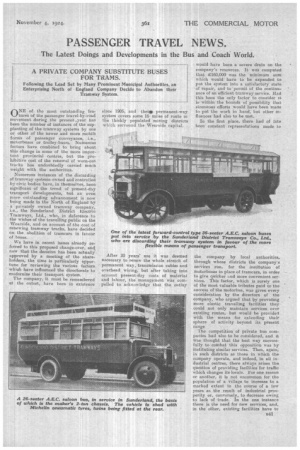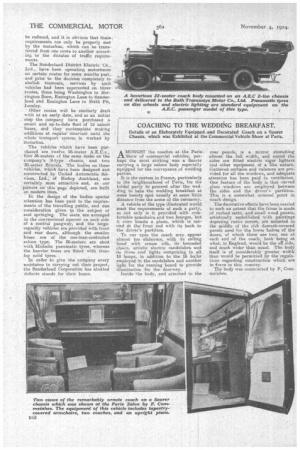PASSENGER TRAVEL NEWS.
Page 25

Page 26

If you've noticed an error in this article please click here to report it so we can fix it.
The Latest Doings and Developments in the Bus and Coach. World.
A PRIVATE COMPANY SUBSTITUTE BUSES FOR TRAMS.
Following the Lead Set by Many Prominent Municipal Authorities, an Enterprising North of England Company Decide to Abandon their Tramway System.
0NE of the most, outstanding features of the passenger travel-by-road movement during the present ,year has been the number of instances of the supplanting of the trnmway systems by one or other of the newer and more mobile forms of passenger conveyance, i.e., motorbuses or trolley-buses. Numerous factors have combined to bring about this change in some of the more important provincial centres, but the prohibitive cost of the renewal of worn-out tracks has undoubtedly carried much weight with the authorities.
• Numerous instances of the discarding of tramway systems owned and controlled by civic bodies have, in themselves, been significant of the trend of present-day transport developments, but an even more outstanding advancement is now being made in the North of England by a privately owned tramway company, i.e., the Sunderland District Electric Tramways, Ltd., who, in deference to the wishes of the travelling public on the Wearside, and on account of the cost of renewing tramway tracks, have decided on the abolition of tramcars in favour of buses.
We have in recent issues already referred to this proposed change-over, and now that the decision has been actually approved by a meeting of the shareholders, the time is particularly opportune for reviewing the various factors whieh have influenced the directorate to modernize their transport system.
The company, it must be remembered at the outset, have been in existence
since 1905, and the* permanent-way system covers some 16 miles of route in the thickly populated mining districts which surround the Wearside capital.
After 20 years' use it was deemed necessary to renew the whole stretch of permanent way, transmission cables and overhead wiring, but after taking into account present-day costs of material and labour, the management was compelled to acknowledge that the outlay would have been a severe drain on the company's resources. It was computed that £160,000 was the minimum sum which would have to be expended to put the system into a satisfactory state • of repair, and to permit of the continuance of an efficient tramway service. Had this been the only factor to consider it is within the bounds of possibility that strenuous efforts would have been made to put the work in hand, but other influences had also to be met.
In the first place, there had of late been constant representations made to
the company by local authorities, through whose districts the company's services run, for the institution of motorbuses in place of tramcars, in order to give 'quicker tmd more convenient services. This factor, which is surely one of the most valuable tributes paid to the success of the motorbus, was given every consideration by the directors of the company, who argued that 1?yproviding more elastic travelling facilities they could not only maintain services over existing routes, but would be provided with the means for extending their sphere of activity beyond its present range The competition of private bus companies had also to be considered, and it was thought that the best way successfully to combat this opposition was by instituting similar services. Then, again, in such districts as those in which the company operate, and indeed, in all industrial centres, there alw ays arises the question of providing facilities for traffic which changes its locale. For one reason or another, it is not uncommon for the population of a village to increase to a marked extent •in the course of a few years as the result of industrial prosperity or, conversely, to decrease owing to lack of trade. In the one instance there is the need for new services, and, in the other, existing facilities have to
be reduced, and it is obvious that theie requirements can only be properly met by the motorbus, which can be transferred from one route to another according to the dictates of traffic requirements.
The Sunderland District Electric Co., Ltd., have been operating motorbuses on certain routes for some months past, and prior to the decision completely to abolish tramcars, services by such vehicles had been superseded on three routes, these being Washington to Iierriegton Burn, Easington Lane to Sunderland and Easington Lane to Sixth Pit, Lumley.
.Other routes will be similarly dealt with at an early date, and as an initial step the company have purchased a smart and up-to-date fleet of lb saloon buses, and they contemplate making additions at regular intervali until the whole transport system is worked by motorbus.
The "vehicles which have been purchased are twelve 26-Seater A.E.C.s., four 36-seaters LI the same make on the
. Company's S-type chassis, and two 30-seater Bristols. The bodies on these vehicles, which have been designed and constructed by United Automobile Services, Ltd.,of Bishop Auckland, are certainly most attractive and, as our picture on this page" depicted, are built on modern lines.
In the design of the bodies special attention has been paid to the requirements of the travelling public, and due consideration given to the subject ot seat springing. The seats, are arranged in the conventional manner on each side of a central gangway, and the largecapacity vehicles are provided with front and rear doors, although the smaller buses are of the one-man-controlled saloon type. The 25-seaters are shod with Michelin pneumatic tyres, whereas the heavier buses are fitted with Dun. lop solid tyres.
In order to give the company every assistance in carrying out their project, the Sunderland Corporation has allotted definite stands for their buses.
































